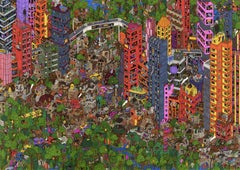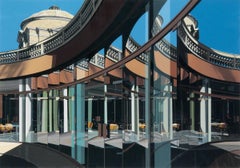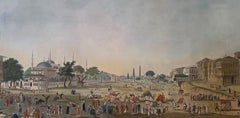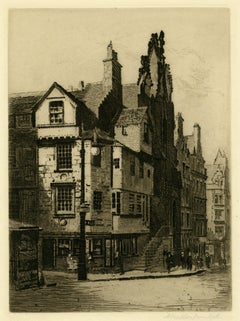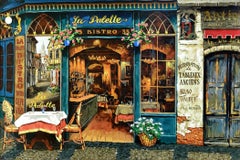This exquisite woodcut after Maurice Utrillo (1883–1955), titled Montmartre, sous la neige (Montmartre, Under the Snow), from the folio Les Peintres mes amis (The Painters My Friends), originates from the 1965 edition published by Editions d'art Les Heures Claires, Paris, and printed by Atelier Raymond Jacquet, Paris, May 20, 1965. Montmartre, sous la neige (Montmartre, Under the Snow) captures Utrillo’s quiet poetry and emotional depth, translating his painterly vision of Paris into the medium of woodcut. The serene winter streets, rendered with rhythmic precision and tonal restraint, evoke the contemplative stillness that defines Utrillo’s deeply personal view of urban solitude and beauty.
Executed as a woodcut on grand velin d'Arches paper, this work measures 15 x 11 inches. Signed in the plate and unnumbered as issued. The edition exemplifies the exceptional standards of Editions d'art Les Heures Claires, Paris, and the master craftsmanship of Atelier Raymond Jacquet, Paris.
Artwork Details:
Artist: After Maurice Utrillo (1883–1955)
Title: Montmartre, sous la neige (Montmartre, Under the Snow), from the folio Les Peintres mes amis (The Painters My Friends), 1965
Medium: Woodcut on grand velin d'Arches paper
Dimensions: 15 x 11 inches (38.1 x 27.94 cm)
Inscription: Signed in the plate and unnumbered as issued
Date: 1965
Publisher: Editions d'art Les Heures Claires, Paris
Printer: Atelier Raymond Jacquet, Paris
Catalogue raisonne reference: Monod, Luc. Manuel de l’amateur de livres illustrés modernes, 1875–1975. Ides et Calendes, 1992, illustration 11485.
Condition: Well preserved, consistent with age and medium
Provenance: From the folio Les Peintres mes amis (The Painters My Friends), published by Editions d'art Les Heures Claires, Paris; printed by Atelier Raymond Jacquet, Paris, May 20, 1965
Notes:
Excerpted from the folio (translated from the folio), The lithographs by Derain and Van Dongen were printed by Lucien Detruit. Those by Dufy, Matisse, Chagall, Dunoyer de Segonzac, Cavailles, Terechkovitch, and Carzou were printed by Mourlot Freres. Those by Picasso and Buffet were printed by P.-J. Ballon. The lithograph by Miro was printed in the workshop Arte, which also printed, in phototype, the frontispiece. The etchings by Villon and Zadkine were printed by Manuel Robbe. That by Braque was printed by A. and P. Crommelynck. The wood engravings and printing of the illustrations by Vlaminck, Rouault, Pascin, and Utrillo were done by Raymond Jacquet. The texts by Andre Warnod, collected by his daughter Jeanine Warnod, were hand-set in De Roos type, size 24, and printed in Paris on the presses of Daragnes. Printing completed on May 20, 1965. Justification of the edition, III examples on large velin d'Arches containing the original copper plates inked for one intaglio illustration; a proof on silk of two lithographs; the four wood-engraved illustrations, mounted; a color separation of one lithograph; and a complete suite of the illustrations on Arches—numbered I to III. XVI examples on large velin d'Arches containing a proof on silk of two lithographs; the four wood-engraved illustrations, mounted; a color separation of one lithograph; and a complete suite of the illustrations on Arches—numbered IV to XIX. XXI examples on large velin d'Arches containing a proof on silk of two lithographs; the four wood-engraved illustrations, mounted; and a complete suite of the illustrations on Arches—numbered XX to XL. XL examples on large velin d'Arches containing a complete suite of the illustrations on Arches—numbered XLI to LXXX. CLXX examples on large velin d'Arches—numbered LXXXI to CCL.
About the Publication:
The folio Les Peintres mes amis (The Painters My Friends), published in Paris in 1965 by Editions d'art Les Heures Claires, stands among the most ambitious postwar French printmaking collaborations. Conceived as a celebration of modern art’s greatest masters, the volume unites original graphic works by Utrillo, Vlaminck, Matisse, Picasso, Chagall, Braque, Villon, Derain, Zadkine, Miro, and others, alongside critical essays by Andre Warnod. Each plate was executed under the supervision of Paris’s foremost ateliers—Mourlot Freres, Lucien Detruit, P.-J. Ballon, Manuel Robbe, and Raymond Jacquet—representing the finest techniques of lithography, etching, and woodcut. This luxurious folio exemplifies the artistry and craftsmanship of mid-20th-century French printing, merging text, image, and handcraft into a unified artistic statement. A triumph of the livre d’artiste tradition, it remains a vital record of the enduring creative dialogue between the painters, printers, and publishers who defined the visual culture of their time.
About the Artist:
Maurice Utrillo (1883–1955) was a French painter whose poetic depictions of Montmartre and Paris transformed the city’s quiet streets, cathedrals, and cafes into enduring symbols of nostalgia and modern beauty. Born in Paris to the artist Suzanne Valadon—model and muse to Pierre-Auguste Renoir and Henri de Toulouse-Lautrec—Utrillo was immersed in art from an early age but led a turbulent life that found solace in painting. Entirely self-taught, he became one of the most distinctive figures of the Paris School, celebrated for his lyrical “White Period” (1909–1914), during which he employed thick impasto and a restrained palette of whites, grays, and ochres to capture the worn facades and atmospheric stillness of Montmartre. Influenced by Paul Cezanne’s structural precision, Vincent van Gogh’s emotional color, and Camille Pissarro’s realism, Utrillo forged a style that blended Impressionist light with Post-Impressionist solidity, expressing solitude, longing, and spiritual calm. He worked amidst the revolutionary ferment of early 20th-century Paris, alongside Pablo Picasso, Amedeo Modigliani, Georges Braque, and Chaim Soutine, yet his art stood apart from their Cubist and Expressionist experiments, focusing instead on evoking emotional truth through representation. Though he shared his generation’s stage with avant-garde icons such as Joan Miro, Salvador Dali, Wassily Kandinsky, Marcel Duchamp, Alexander Calder, Alberto Giacometti, and Man Ray, Utrillo’s paintings offered a poetic counterpoint—a meditative realism that captured the enduring soul of modern life. His mastery of perspective and tonal harmony imbued works like Rue Norvins and Place du Tertre with quiet majesty, transforming ordinary streets into sanctuaries of memory and light. Utrillo’s profound sensitivity influenced later artists including Balthus, Jean Dubuffet, Nicolas de Stael, and Giorgio Morandi, as well as Edward Hopper and Wayne Thiebaud, who echoed his stillness and emotional clarity in their own depictions of urban solitude. His art, now housed in major museums such as the Musee d’Orsay, Centre Pompidou, Metropolitan Museum of Art, and Tate, remains a cornerstone of modern French painting, bridging the lyricism of Impressionism with the introspection of modernism. Revered for his sincerity and mastery of mood, Utrillo stands alongside Picasso, Miro, Dali, Kandinsky, Duchamp, Calder, Giacometti, and Man Ray as a pillar of 20th-century art, his work capturing the eternal poetry of Paris. The highest auction record for Maurice Utrillo was achieved by his masterpiece Rue Norvins a Montmartre (circa 1910), which sold for $4,882,500 USD at Sotheby’s, New York, on November 6, 2011, affirming his enduring legacy as one of the most beloved and collectible painters of his era.
Maurice Utrillo Montmartre...
